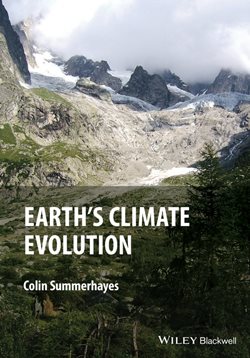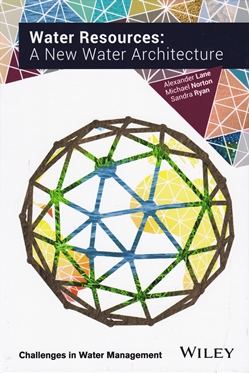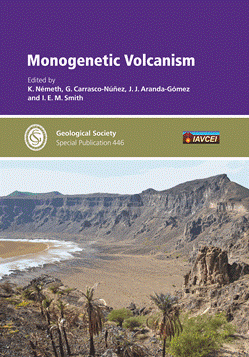 Earth's Climate Evolution
Earth's Climate Evolution
First things first. This is a marvellous book: the best serious, all-round, in-depth book on palaeoclimate I have encountered. If you have space on your bookshelf for just one properly substantial volume on this huge and many-faceted topic – well, look no further. This is it.
It is a scholarly book, excavating deep into its subject on the basis of primary literature (some 1400 scientific papers are cited), and focusing both on the processes that affect planetary climate, from the Sun’s radiation, to the forms of heat control exerted by oceans, atmosphere and land, to classically geological factors such as palaeogeography, while carbon dioxide plays a central role in the narrative, in the Earth’s deep past as today. The book explains complex themes in depth, from astronomical cycles, to carbonate chemistry, multi-proxy stratigraphic analysis and climate modelling.
The amount and range of subject matter here can be overwhelming, but the reader is helped by the style and narrative form: the story is told through the characters who built the science. This pattern is set with the early days of climate science, taking in both the geological evidence assembled by the likes of Buffon and Buckland, Lyell and Agassiz, and the physico-chemical advances of such luminaries as Fourier, Tyndall and Arrhenius.
The style is maintained in recounting more recent breakthroughs, where Nick Shackleton, Jane Francis, Bill Ruddiman, Maureen Raymo, Wallace Broecker and many others take their turn on centre stage. The combination of human and research interest allows the learning to be worn lightly, even as the author delves deeply into scientific detail. The momentum of the narrative is maintained by clear and fluent writing.
There is a focus, almost unavoidable, on the younger end of the geological column, mostly the Cenozoic and particularly the Quaternary. Older events do figure – there is honourable mention of Phanerozoic carbon modelling, Cretaceous climates and so on. But it is the detailed record of the past few millions of years, and few millennia, that are highlighted. The new climate trajectories of recent times are nicely integrated into the wider palaeoclimatic context, and commented on pithily and appropriately.
There are some glitches. The index is of ‘things’ only, and does not include people – an annoying omission that should be remedied in any new edition. But this is a minor gripe. Overall, the book is terrific.
Reviewed by: Jan Zalasiewicz
EARTH’S CLIMATE EVOLUTION by COLIN SUMMERHAYES Published by: Wiley-Blackwell 2015. 410pp hbk. ISBN-13: 978-1-118-89739-3 List Price: £60.00. Kindle Edition: £54.00 Website
 Water Resources – a new water architecture
Water Resources – a new water architecture
Water is often cited as the ultimate example of the renewable resource. There’s little doubt that that is true. The fact remains, however, that more than seven billion people need access to it for very many and wide-ranging purposes. As the world’s population grows, water scarcity and shortage are becoming increasingly common, and will continue to do so. This excellent book sets all that out in the context of the inadequate and inappropriate resource management that, as it says, is “already taking its toll on the quality of life of millions of people”. It also notes that much of the old-style management was valid when the resources available were relatively free of stress – from Roman times until, perhaps, the 20th Century. The problems arose with the arrival of water-resource stress, and can only be expected to get worse.
The text is well constructed, comprising sections dealing in turn with the current water resource scene, stresses and strains – covering living, eating, and water consumption, and introducing concepts like water fluxes and virtual water – existing water architecture - and the proposed means of attaining the new architecture. The latter ends with a potential way forward. The larger part of the text is very well written, although a small amount is slightly shaky, and many of the statistics and facts are fascinating and astounding. It would be reasonable to describe them as shocking, too, if emotional terms seemed fitting.
The text is supported by many figures, tables and breakout boxes, which, between them, go a long way toward clarifying the more complex issues and concepts. My one quibble is that some of the figures – only a few – have been compressed so far that they are quite hard to read. The book deserves better than that, and judicious expansion of selected figures could be used to absorb some of the several blank pages at the end.
This is a well written book on a subject of ever increasing importance – it seems, at best, very unlikely that water stress will go away anytime soon – and is highly recommended. I am delighted to have it on my shelves and imagine that it might be rather well thumbed in a few years’ time. All chapters end with extensive and useful reference lists, making the book a valuable source of external information, in addition to the stunning statistics in its own first, and rather larger, half.
Reviewed by Jeremy B Joseph
WATER RESOURCES – A NEW WATER ARCHITECTURE by ALEXANDER LANE, MICHAEL NORTON AND SANDRA RYAN, 2017. Published by: Wiley-Blackwell (J W Wiley & Sons), Chichester, UK. ISBN: 978-1-118-79390-9. Hbk. 328 pp. List Price: £99.99. Website
 Salt Tectonics: Principles and Practice
Salt Tectonics: Principles and Practice
Right up until his untimely death in May 2016, Martin Jackson was working; and the posthumous publication of this book with his University of Texas at Austin colleague Mike Hudec is a fitting tribute to his dedication to salt tectonics. The volume is well written, superbly illustrated and clearly a labour of love, borne from a life-long devotion to structural geology and halokinesis.
The book is separated into four main sections covering Evaporite Deposition and Flow; Salt Structures; Salt Tectonic Systems; and Practical Applications of Salt Tectonics. Each is subdivided into component chapters.
The first section begins with a short but wide-ranging overview outlining the importance of salt. While I am not sure the excavated head of an Iranian Iron Age miner was really needed, it did cause me to sit up and think: this is not going to be a run-of-the-mill textbook. The next two introductory chapters describe evaporite minerals, the depositional settings in which they occur, their material properties, rock mechanics, the laws that govern salt flow and the importance of elastic deformation, fracture strength, creep rheology, forces that drive salt movement and the microstructures that result.
A series of six chapters makes up the second section, describing pillows, anticlines, stocks, walls, sheets, canopies, mini-basins and welds. The next section examines the interaction between structures in linked salt-tectonic systems, including basement-detached extensional deformation, turtle-back structures, rift-raft tectonic geometries, the structural styles that characterise rifts and passive margins, contractional salt-tectonic systems, drawing upon examples from onshore fold-and-thrust belt, deep marine toe-thrust, basin inversion and strike-slip settings.
The fourth and final section provides useful pointers for seismic interpreters who seek to identify prospective parts of a basin. It also touches upon key issues like depth conversion and data distortion and their consequences for mapping and guidance on how to recognise feeder systems and mini-basins that are encased in salt. The last chapter focuses on the key elements of the petroleum system including a description of stratigraphic traps located on the flanks of salt diapirs, and drilling hazards.
In conclusion, this is an excellent book. Allowing for the omission of igneous interactions with salt, it is arguably the most comprehensive textbook on salt tectonics and is essential reading for anyone wishing to get up-to-speed with the latest thinking on the subject.
Reviewed by John Underhill
SALT TECTONICS: PRINCIPLES AND PRACTICE by MARTIN P A JACKSON & MICHAEL R HUDEC 2017. Published by: Cambridge University Press. ISBN: 9781107013315 (hbk) List Price: £49.99. Website
 The Geometry & Growth of Normal Faults
The Geometry & Growth of Normal Faults
Normal faults are the fundamental crustal structures that accommodate extension within extensional sedimentary basins, developed in continental rifts and passive margin settings. Their geometry and growth are intimately linked, and the current understanding of how these faults grow is directly derived from observations of fault geometry. This volume is the outcome of a conference (of the same title) held at the Geological Society of London in 2014 in honour of a pioneer in the field, Juan Watterson.
Introduced with an overview paper from the editors, the volume presents 23 papers covering the current research into the geometry and growth of normal faults. Organised into five thematic sections - Fault geometric analysis, Fault kinematic analysis, Fault zone structure, Fault-related folding and Pre-existing structure and reactivation – these papers present the latest research outcomes from both outcrop and subsurface studies of the geometrical evolution of normal faults from several significant global basins.
Further complementary studies using analogue and numerical modelling techniques are included and underpin the current understanding of the fundamental aspects of normal fault kinematics. Research topics are varied and include how fault length evolves with displacement, how faults interact with each other, the controls exerted by pre-existing structure on fault development and the nature and origin of fault-related folding.
The volume provides an in-depth description of current models of fault growth, and discusses the methods by which these models can be investigated. The main focus of the volume emphasises how geometric observations provide constraints on fault growth.
The anticipated readership would be from both academic researchers and industry professionals who are interested in acquiring an up-to-date and ‘holistic’ understanding of the structural geological aspects of the development of normal faulting. In summary, the volume provides an excellent overview of recent interdisciplinary geoscientific developments within this important and evolving field. The contributions are well written and edited, complemented with appropriate figures, photographs and data-tables - features one has come to expect from the GSL Special Publication series. Editors and contributors are to be congratulated on an informative - and recommended - read.
Reviewed by Mark Griffin
THE GEOMETRY AND GROWTH OF NORMAL FAULTS by CHILDS, C, HOLDSWORTH, R E, JACKSON, C A-L, MANZOCCHI, T, WALSH, J J and YIELDING, G (eds). 2017 Published by: The Geological Society of London SP439. ISBN 978-1-86239-967-9. Hbk. 540pp. ISSN 0305-8719. List Price: £120.00, Fellows’ Price, £60.00. Website
 Monogenetic Volcanism
Monogenetic Volcanism
We are quickly made acutely aware of the complexity and intrigue surrounding monogenetic volcanism; a topic that has, until fairly recently, fallen within the shadow of those deemed more volcanologically compelling, despite being the most abundant type of volcano on Earth. Recent IAVCEI (International Association of Volcanology and Chemistry of the Earth’s Interior) conferences have led to this publication, a compilation of 14 papers. As a collective entity, these papers serve in laying the foundations of current understanding in a subject of which we are still fundamentally scratching the surface, while also frequently delving deeper and yet remaining highly self-aware of the flaws and drawbacks that still remain within the scope of current research and existing models.
The structure and flow of the publication initially promises a varied global outlook upon the subject but soon refines the worldwide perspective to focus upon central and southern American regions. With this convergence of attention comes the chance to inspect and compare more closely the dynamics at play. The crux of this volume dwells on the visual subaerial products of various forms of monogenetic volcanism and their relation and nature of occurrence with respect to their multi-faceted subterranean counterparts, as well as incorporating eruptive styles. From individual maar diatremes and kimberlite pipes to large-scale volcanic fields and igneous provinces, there is a plethora of insight - including a particularly illuminating segment on Isla Isabel, an isolated volcanic island that has remained relatively uncharted and has until now held more questions than answers.
Several papers highlight the debate and ‘paradoxical situation’ surrounding monogenetic volcanoes in terms of their universally accepted premise, classification and nomenclature (especially when considering their comparison with polygenetic volcanoes as less like clear-cut contrasting endmembers and more akin to a transitional intermingling scale), and this volume at times has occasionally a similarly ‘disjointed’ feel. This is perhaps induced partly by the differing emphases and approaches towards the subject, wavering depth of analysis, as well as the subtly varying levels of audience that it seems to be addressing. Having said this, it does add to the effect and, overall, consolidates the feel of a comprehensive study - engaging and appropriate for a multitude of purposes.
Though occasional editing and formatting quirks may be slightly distracting (some images and diagrams would have benefited from colour for the sake of clarity and lack of ambiguity) the undeniable strength of this publication is the work - intertwined throughout the volume - on maar diatreme volcanoes.
Reviewed by Ayla Stenning.
MONOGENETIC VOLCANISM by NÉMETH K, CARRASCO-NÚÑEZ G, ARANDA-GÓMEZ J J & SMITH I E M, 2017. Published by: The Geological Society of London SP446, 388pp (hbk), ISBN: 978-1-78620-276-5, List Price: £110.00. Fellows’ Price £55.00 Website
 New Perspectives on Pterosaur Palaeobiology
New Perspectives on Pterosaur Palaeobiology
There is an English idiom that says ‘don’t judge a book by its cover’: however in this case I would advise the reader to do just that! This Geological Society Special Publication has been published to disseminate papers and posters presented at the Flugsaurier 2015 meeting, which was held at the University of Portsmouth, and from the excellent artwork on the front to each of the papers contained within, it is a very high-quality product.
It encompasses a wide range of papers on pterosaurs, including their taxonomy, behaviour, ecology and relationships. Often languishing in the shadow of the dinosaurs in the literature, these papers show that these enigmatic creatures have given rise to a strong research-base. The papers are an excellent mixture; some concentrating on the development of our understanding of individual species, others covering the pterosaurs’ place in the wider Mesozoic world. What is clear is that the world of pterosaur research is alive and well and that despite having the longest research history of any extinct vertebrate group, there still remains much to learn.
The discovery of many excellent specimens in lagerstätten in both China and Brazil has undoubtedly led to the recent surge in interest in this vertebrate group. It would have been easy to allow this volume to have concentrated on some of these spectacular new finds, so the editors are to be congratulated on putting together a balanced volume that has something for everyone who is interested in studying these animals and their place in Mesozoic ecosystems.
Depending on one’s own interest, there will be papers that will attract your special attention, whether it be the more systematic palaeontology of a new species or a review of pterosaur skull-strengths. The quality of the diagrams, graphs and images in each of the papers presented is very high. This is a book that can be dipped into or read straight through – there genuinely is something for everybody with even a passing interest in palaeontology. It adds significantly to our knowledge of Mesozoic life, and deserves a wide readership.
Reviewed by Gordon Neighbour
NEW PERSPECTIVES ON PTEROSAUR PALAEOBIOLOGY by HONE D W E, WITTON M P & MARTILL D M (Eds) 2017. Published by: The Geological Society of London SP 455. List Price: £90.00 Fellows’ Price: £45.00. Website